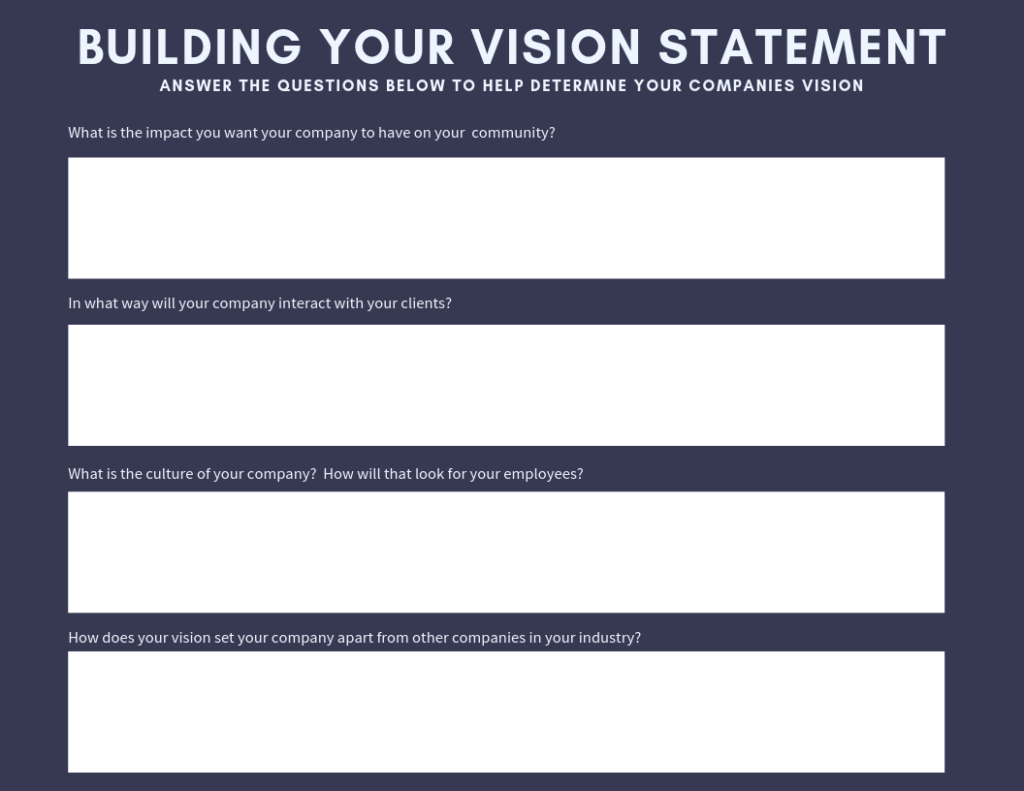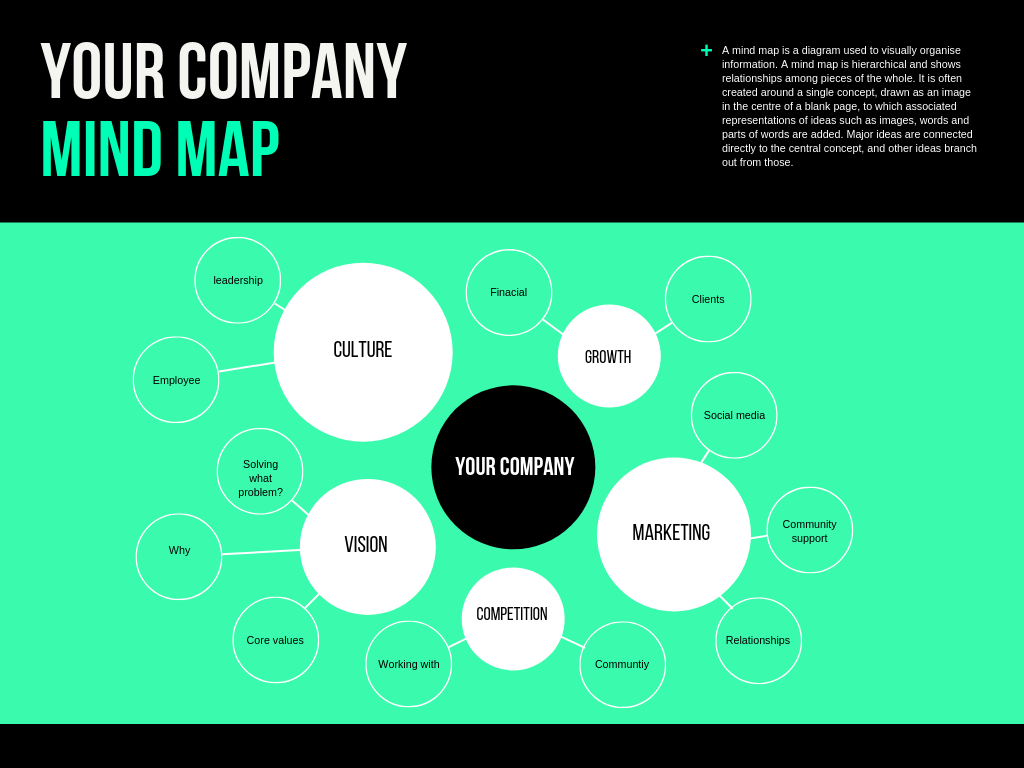Discover your why
Finding your WHY for your business (Creating a vision statement)
“This relationship starts to clarify the difference between a vision statement and a mission statement in an organization. The vision is the public statement of the founder’s intent, WHY the company exists. It is literally the vision of a future that does not yet exist. The mission statement is a description of the route, the guiding priniciples- HOW the company intends to create that future.”
– Simon Sinek
Learning Objectives
In this last chapter of the section, we will tie everything together to develop a vision statement for your company.
This chapter will help you:
- Explain the difference between a mission statement and a vision statement.
- Design a mindmap to guide you in the building of a company vision statement.
- Complete a vision statement for your company.
You have spent some time reflecting on your personal core values. You then linked these values to your business. Next, you spent some time reflecting on your personal WHY. In this chapter, we are going to take your WHY and create your businesses vision statement.
Writing your businesses vision statement can be an intimidating task. At best, a powerful vision statement can guide your company, set the tone, let people know what you’re all about. At worst, a vision statement is a plaque that sits in your office or a slogan that is posted on the homepage of your website.
What is a vision statement?
It is important to start this by defining what a vision statement is not. A common mistake is assuming that a vision statement is the same thing as a mission statement. A mission statement is focused on the what and how. Mission statements answer questions like:
- What do we do?
- Whom do we serve?
- How do we serve them?
A vision statement, on the other hand, is something that guides the company, something that gives the company direction. A vision statement would answer questions such as:
- What are the companies hopes and dreams?
- What problem are we solving for the greater good?
- Who and what is our business trying to inspire?
- What is our companies WHY?
Getting started
A business vision statement should engage your imagination and passion while at the same time providing guidance. A vision statement must not only resonate with you but also with your employees and clients. It is what is going to attract those you want to work with and work for. Get started by asking some questions:
-
- What is the impact you want your company to have on your community?
- In what ways will your company interact with your clients?
- What is the culture of your company? How will that look for your employees?
- How does your vision set your company apart from other companies in your industry?
Exercises
- Download the PDF and work through the questions.
- Take some time to reflect and your personal and companies values.
- Start crafting your companies vision statement. Share it with someone who understands your business for their feedback.
So it is written
Now comes the time to craft your vision statement. Likely you have heard the term elevator pitch; a short description of an idea that can be explained fully in the time it takes for an average elevator ride. This concept holds true for crafting your companies vision statement as well. It should be short and sweet. It should avoid business jargon and should be put in a way everyone will understand. Your vision statement should be specific to your business and should incorporate the values you determined earlier.
Some things to consider when starting to craft your vision statement:
- Align it with your personal and business company core values.
- Use the present tense.
- Use concise unambiguous language.
- Make it inspiring and exciting.
- Dream big.
Here are examples of vision statements from companies you may have heard from:
To be earth’s most customer-centric company where customers can find and discover anything they might want to buy online
-Amazon
A world where everyone has a decent place to live
– Habitat for humanity
Inspire the world, create the future.
– Samsung
To create a better everyday life for the many people
-IKEA
Your vision statement sucks
As amazing and inspiring as all the vision statements above are, ask yourself, do they really provide an idea of what the companies do? Yes, they do offer inspiration, give a glimpse into what the world view of the company is about, but do they really tell you how they do this? One of the important things that a vision statement can add is a point that others can align to. A vision statement is to show your clients and your employees what your company values, the impact you would like it to have on your community, and where it is going.
In the video below Cameron Harold, the COO of 1-800-GOT-JUNK, discusses what he calls a “vivid vision”. This is a document that visualizes how you want your company to look in the next 3 years. This takes creating just a single vision statement and turns it into something that offers not only platitudes but some solid values and goals that your employees and clients can align to.
In the video, Cameron discusses creating a mind map. This mind map serves as a guide for the actual document. There are many ways to start creating mind maps. There is software that can help you with the process, or you can sit down with pen and paper and start drawing it out. Below is an example of a mind map that you can use as a template. When you are working on it, make sure you take time alone and dream big. Write down everything that comes to your mind. Where do you want the company to be in the next three years? What type of culture do you want to create within your company? What are some of the words do you want your employees to describe your company? Everything is fair game and nothing is off-limits.
Exercises
- Take some time and mind map out your vision statement for your company. Where do you want to see your company in the next three years? There are a lot of different options for how this is done. You can use apps like Canva or Coggle, or you can sit down with a pen and paper and start drawing it out.
- After you have a mind map built take some time to reflect on it. Is there anything you would like to add? Does it inspire you? Share it with others, does it inspire them?
- Write it out. Now that you have a visual, take some time and write out the vision statement. Put it into a format that you can share. If you have a team you work with, share it with them and make it open for edits.
Nothing is set in stone
As you start to build your business you can use your vision statement as a guiding light for where you are heading. There also may come a time when may need to change direction. There is nothing that says that once you write out your vision statement you can’t change it. In fact, you will more than likely want to change it often. Especially in the early days of your business you don’t want your vision statement to blind you to opportunities or limit your opportunity for growth.
If, for any reason, your vision statement stops feeling right don’t be afraid to change it.
At the end of the day, your vision statement should be a reminder and guide to you, your employees and your clients as to why the business exists. The vision is bigger than just the day, or the project. This reminder will come in handy during the good times in your business, and also the more challenging and difficult times.
References/Resources
- TEDx Talks. (2018, June 8). Your vision statement sucks. [https://youtu.be/GCgK5M3hY8Y]. Retrieved from https://youtu.be/GCgK5M3hY8Y
- Herold, C. (2018). Vivid Vision: A remarkable tool for aligning your business around a shared vision of the future. Austin, Texas. Lionscrest publishing.



